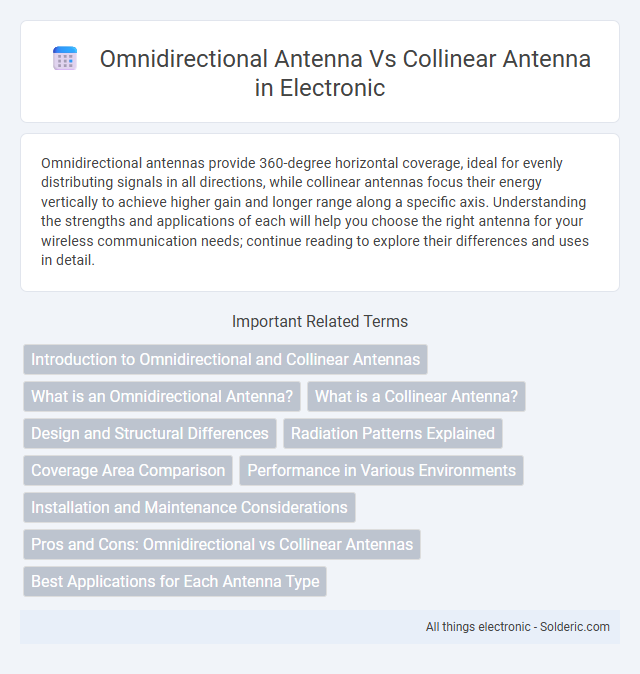Omnidirectional antennas provide 360-degree horizontal coverage, ideal for evenly distributing signals in all directions, while collinear antennas focus their energy vertically to achieve higher gain and longer range along a specific axis. Understanding the strengths and applications of each will help you choose the right antenna for your wireless communication needs; continue reading to explore their differences and uses in detail.
Comparison Table
| Feature | Omnidirectional Antenna | Collinear Antenna |
|---|---|---|
| Radiation Pattern | 360deg horizontal coverage | 360deg horizontal, enhanced vertical gain |
| Gain | Typically 2-5 dBi | 6-9 dBi, higher than standard omni |
| Application | General wireless communication, mobile devices, Wi-Fi | Long-range communication, base stations, repeaters |
| Structure | Single element or simple array | Stacked dipole elements, multiple sections |
| Vertical Beamwidth | Wide, less focused | Narrow, focused for extended range |
| Polarization | Vertical or horizontal | Usually vertical |
| Use Case | 360-degree coverage in all directions | Directional vertical coverage with high gain |
| Cost | Lower cost, simple design | Higher cost due to complex design |
Introduction to Omnidirectional and Collinear Antennas
Omnidirectional antennas radiate radio frequency energy uniformly in all horizontal directions, making them optimal for broad area coverage in applications like Wi-Fi and cellular networks. Collinear antennas consist of multiple vertically stacked dipole elements that create a narrow vertical radiation pattern with increased gain, enhancing signal strength and range in point-to-multipoint communications. The choice between omnidirectional and collinear antennas depends on coverage requirements, with omnidirectional suited for 360-degree horizontal coverage and collinear favored for extended range in specific directions.
What is an Omnidirectional Antenna?
An omnidirectional antenna radiates radio frequency signals uniformly in all horizontal directions, providing 360-degree coverage ideal for broad area communication. Unlike collinear antennas, which stack multiple elements to increase gain and focus signals in a specific direction, omnidirectional antennas prioritize consistent signal distribution over range. Your wireless network benefits from omnidirectional antennas when seamless coverage around a central point is essential, such as in Wi-Fi routers or cellular base stations.
What is a Collinear Antenna?
A collinear antenna consists of multiple dipole elements stacked vertically to provide increased gain and a focused omnidirectional radiation pattern in the horizontal plane. Designed to enhance signal strength and range, it is commonly used in applications like base stations, repeaters, and cellular networks. Your network performance can benefit from its ability to maintain consistent coverage over a wide area while minimizing interference in unwanted directions.
Design and Structural Differences
Omnidirectional antennas radiate radio waves uniformly in a 360-degree horizontal plane using a vertical dipole design, while collinear antennas consist of multiple dipole elements stacked vertically to increase gain and directivity. The structural arrangement of collinear antennas enhances vertical radiation patterns without sacrificing horizontal coverage, making them ideal for long-range communication. Your choice depends on whether you prioritize uniform signal distribution or increased range with focused vertical gain.
Radiation Patterns Explained
Omnidirectional antennas radiate signals uniformly in all horizontal directions, forming a 360-degree radiation pattern ideal for covering broad areas. Collinear antennas consist of multiple dipole elements stacked vertically, producing a more focused, high-gain radiation pattern with increased range and reduced signal loss in horizontal planes. Understanding these radiation patterns helps you select the right antenna based on whether you need widespread coverage or targeted signal strength.
Coverage Area Comparison
Omnidirectional antennas provide 360-degree horizontal coverage, ideal for broadcasting signals evenly in all directions, making them suitable for environments requiring broad area connectivity. Collinear antennas concentrate their signal vertically with multiple stacked elements, offering increased gain and extended range primarily along a horizontal plane, optimal for long, narrow coverage zones such as along streets or corridors. Understanding your coverage area needs helps determine whether the uniform surround coverage of an omnidirectional antenna or the focused, high-gain reach of a collinear antenna best enhances your wireless network performance.
Performance in Various Environments
Omnidirectional antennas provide 360-degree horizontal signal coverage, making them ideal for open or urban environments where signals need to be broadcast evenly in all directions. Collinear antennas offer higher gain with a narrower vertical beamwidth, enhancing performance in flat areas or along linear paths like highways, but may struggle with multipath interference in dense urban settings. Choosing the right antenna affects your signal reliability and range depending on specific environmental challenges such as building density and terrain.
Installation and Maintenance Considerations
Omnidirectional antennas typically require simpler installation due to their single vertical element design, minimizing alignment efforts and enabling easy mounting on poles or rooftops. Collinear antennas demand precise vertical alignment and secure mounting to maintain optimal performance, often involving a more complex setup process with multiple stacked elements. Maintenance for omnidirectional antennas is generally lower, while collinear antennas may require periodic inspection to ensure elements remain properly aligned and connections are secure to prevent signal degradation.
Pros and Cons: Omnidirectional vs Collinear Antennas
Omnidirectional antennas provide 360-degree horizontal coverage, ideal for broad area communication but typically offer lower gain and shorter range compared to collinear antennas. Collinear antennas focus signal vertically, delivering higher gain and improved range, making them suitable for long-distance, point-to-multipoint applications but with limited horizontal coverage. The choice depends on whether wide area coverage or longer range with directional focus is prioritized for the wireless network.
Best Applications for Each Antenna Type
Omnidirectional antennas excel in applications requiring 360-degree horizontal coverage, such as mobile communication devices, Wi-Fi routers, and public safety radios, where signals must reach users in all directions. Collinear antennas are ideal for long-range point-to-multipoint communication, often used in cellular base stations, marine VHF systems, and rural broadband networks due to their high gain and focused vertical radiation pattern. Choosing the appropriate antenna depends on the need for either comprehensive horizontal coverage or extended range with concentrated signal strength.
omnidirectional antenna vs collinear antenna Infographic

 solderic.com
solderic.com